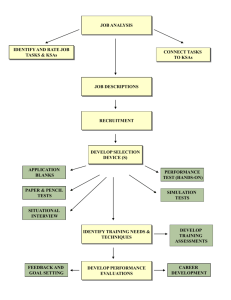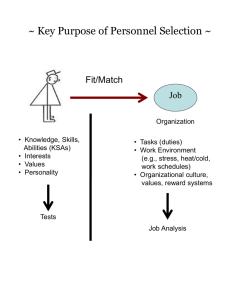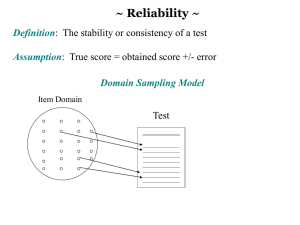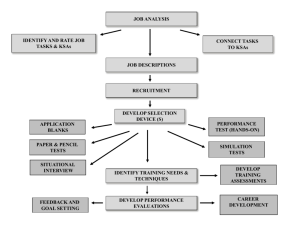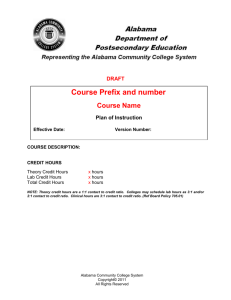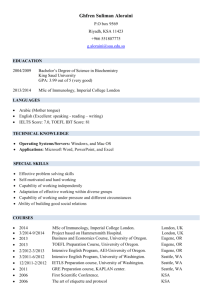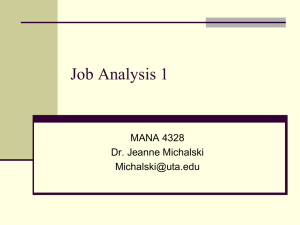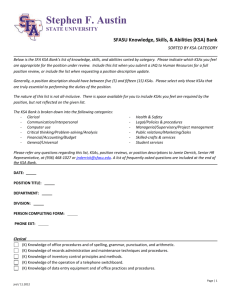Job Analysis slides
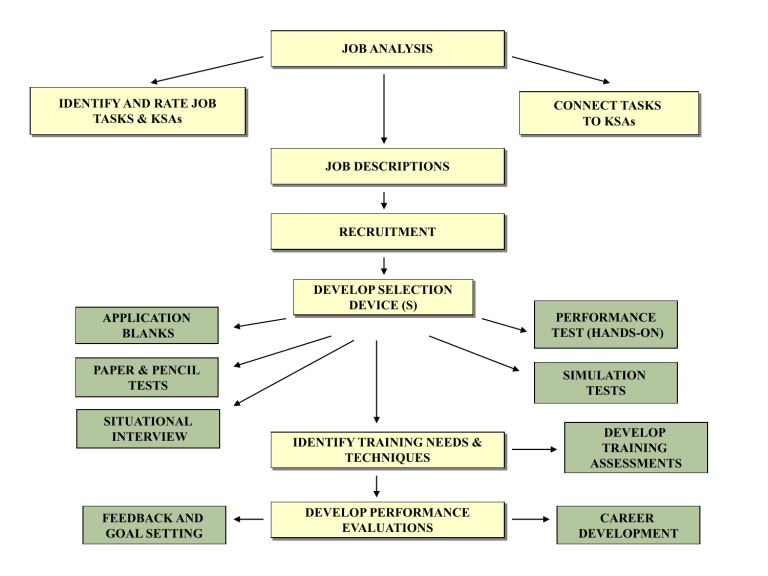
IDENTIFY AND RATE JOB
TASKS & KSAs
APPLICATION
BLANKS
PAPER & PENCIL
TESTS
SITUATIONAL
INTERVIEW
FEEDBACK AND
GOAL SETTING
JOB ANALYSIS
CONNECT TASKS
TO KSAs
JOB DESCRIPTIONS
RECRUITMENT
DEVELOP SELECTION
DEVICE (S)
IDENTIFY TRAINING NEEDS &
TECHNIQUES
DEVELOP PERFORMANCE
EVALUATIONS
PERFORMANCE
TEST (HANDS-ON)
SIMULATION
TESTS
DEVELOP
TRAINING
ASSESSMENTS
CAREER
DEVELOPMENT
Basic Methods to Collect Job Analysis Information
Interviews ( Individual or group )
Format: Individual or group with SME (Subject Matter Experts)
SMEs: Employees and/or supervisors
Key Points:
• Make purpose of the job analysis clear
• Interviewers need to be trained
• Use a structured format
Potential Limitations:
Employees may distort the responsibilities of their job
Supervisors may lack detailed information as to how the job is done
On-Site Observation
• Best used for structured jobs
• Need to get a representative sample
• Need to be unobtrusive
• Beneficial to use a structured format to record observations (see pg. 221 in text; FJA)
Note: Some suggest that it’s best to observe before conducting interviews.
In some cases, observations may not be possible (e.g., safety concerns, union objections)
Questionnaires ( e.g., Position Analysis Questionnaire; PAQ )
Dimensions measured by the PAQ: a) Where and how employees get job/task information b) Cognitive process involved (e.g., planning, organization, making decisions) c) Output (e.g., activities performed, tools/processes used) d) Interpersonal relationships required (e.g., co-workers, clients) e) Context of job (physical and social)
Advantages:
• PAQ can allow comparisons and generalizations across jobs
• Decent internal consistency reliability (.80)
• Inter-rater reliability of .66
Limitations:
• Cannot clarify questions or follow up on respondents answers
• Best used for manual labor jobs (lots of items related to equipment use)
• Relatively high reading level level (10th - 12th grade)
• Task differences may not be measured due to behavioral similarities
“Typical” Job Analysis Process
Develop Task Statements
Develop KSA Statements
Rate Task & KSA Statements
Connect Tasks & KSAs
Job Analysis Process for Employment Selection
1.
Identification of work activities and development of job task statements
2.
Develop a list of KSA’s necessary for adequate performance of the job tasks
3.
Site observations to confirm and substantiate findings
4.
Evaluate job tasks and KSA statements to discern (and document) their jobrelatedness
5.
Generate test items and evaluate their job-relatedness, or select existing tests for their job-relatedness
6. Construct test instruments and assess their validity for purposes of selection/promotion decisions
Basic Task Statement Components
1) What is the action being performed? (using an action verb)
2) To Whom/What is the action directed? (the object, or receiver, of the action verb)
3) How is the action performed? (e.g., use of certain procedures, equipment, tools).
The “how” is arguably the most crucial part of the task statement in that it directly relates to KSAs
4) Why is the action being performed? (the purpose of the action). Often, it is preceded by words such as “in order to” or “so as to.” Be careful not to confuse the
“why’ part of the statement with the “what” section
Sample Task Statement
What?
To What?
Inspects (Visually or manually) parts, equipment, and systems such as valves, thermostats, filters, motors, pumps, space heating equipment, boilers, generators, incinerators, burner systems, air
How?
handling units and piping systems by using calibration equipment, hand tools, multi-meters, and temperature and pressure gauges following oral and/or written instructions (e.g., supervisor
Why?
directives, operator manuals) in order to comply with maintenance requirements and determine the cause of malfunctions.
Sample Task Statements
1) Performs mathematical, algebraic, and geometric computations, such as fractions to decimals, metric units to English, computing ratios and percentages, and calculation of area and volume by using rules, charts, formulas, calculators, and tables in order to maintain a variety of mechanical equipment.
2) Performs a variety of measurements such as motion, forces, temperature, and fluid properties using temperature thermostats, barometers, motion detectors, and pressure gauges in order to obtain a reading.
3) Lifts materials of varying weights and sizes such as pumps, blowers, piping, valves, and rotating and reciprocating equipment by the proper and safe use of hoists, pulleys and rigging accessories in order to set and maintain equipment and avoid personal injury and property damage.
4) Measures objects, shafts, and distances using non-precision and precision instruments such as rulers, inside and outside calipers, micrometers, and dial indicators in order to check for clearances, tolerances, and discrepancies.
Sample KSA Statements
A) Ability to perform mathematical operations, using a calculator, to compute conversions, ratios, and percentages.
B) Ability to select and use a variety of precision and non-precision measuring instruments.
C) Ability to troubleshoot equipment by using an analytical, step-by-step process, standard procedures, and troubleshooting guides.
D) Knowledge of mechanical principles, terminology, and equipment
E) Ability to read, comprehend, and follow complex written instructions and procedures.
F) Ability to transport equipment and supplies weighing up to 100 pounds either manually or with the use of equipment (e.g., hoists, hand trucks) for a distance of 30 feet.
6
7
4
5
8
1
2
3
11
12
9
10
Task Rating Form
A B
Frequency of use Importance of performing successfully
C D E
Importance for new hire Distinguishes between superior & ad performance
Damage if error occurs
5 = almost all of the time
4 = frequently
3 = occasionally
2 = seldom
1 = not performed at all
5 = extremely important
4 = very important
3 = moderately important
2 = slightly important
1 = of no importance
5 = extremely important
4 = very important
3 = moderately important
2 = slightly important
1 = of no importance
5 = a great deal
4 = considerably
3 = moderately
2 = slightly
1 = not at all
5 = extreme damage
4 = considerable damage
3 = moderate damage
2 = very little damage
1 = virtually no damage
Importance for acceptable job performance
KSA Rating Form
Importance for new hire
K
L
I
J
M
N
G
H
E
F
C
D
A
B
5 = extremely important
4 = very important
3 = moderately important
2 = slightly important
1 = of no importance
5 = extremely important
4 = very important
3 = moderately important
2 = slightly important
1 = of no importance
Distinguishes between superior
& adequate performance
5 = a great deal
4 = considerably
3 = moderately
2 = slightly
1 = not at all
5
6
7
8
9
2
3
4
KSA
Job
Tasks
1
10
11
12
TASK -- KSA MATRIX
To what extent is each KSA needed when performing each job task?
A B
5 = Extremely necessary, the job task cannot be performed without the KSA
4 = Very necessary, the KSA is very helpful when performing the job task
3 = Moderately necessary, the KSA is moderately helpful when performing the job task
2 = Slightly necessary, the KSA is slightly helpful when performing the job task
1 = Not necessary, the KSA is not used when performing the job task
C D E F G H I J K L M N O P Q R
A Legally Defensibly Job Analysis
1) A job analysis must be performed on the exact job which the selection/promotion device is to be used
2) The analysis must be reduced to a written form (e.g., a job description)
3) The job analyst must be able to describe the procedures used to collect information
4) Data must be collected from several up-to-date sources
5) Data must be collected by a qualified job analyst
6) Data must be collected from a large enough sample of individual for the job in question
7) Tasks, duties, and activities must be identified and the relative degree of competency required must be specified
8) KSAs are mentioned most frequently as the type of information to be identified through a job analysis
9) Task specification is seen as a prerequisite to an acceptable job analysis
Kirkland v. Department of Correctional Services (1974)
"Without such an analysis (job analysis) to single out the critical knowledge, skills and abilities required by the job, their importance
relative importance to each other, and the level of proficiency demanded as to each attribute, a test constructor is aiming in the dark and can only hope to achieve job relatedness by blind luck”
A) The KSAs tested for must be critical to successful job performance
B) Portions of the exam should be accurately weighted to reflect the relative importance to the job of the attributes for which they test c) The level of difficulty of the exam material should match the level of difficulty of the job
Checklist Used to Match Selectors with Job Requirements
Job Requirements
1. Ability to perform calculations and understand
Charts, formulas and tables.
2. Ability to read prints and drawings
3. Ability to troubleshoot mechanical equipment.
4. Knowledge and use of safe practices when handling
Materials and tools.
5. Ability to use & care for hand and power tools to maintain mechanical
Equipment.
6. Knowledge of basic principles of hydraulic, pneumatic, and compressed air systems.
Application
Form
Selection Method
H.R.
Employment
Interview
Paper and
Pencil Test
Technical
Interview
Prerequisites
Previous work experience in hazardous work environments
Relevant experience and training in mechanical maintenance.
Work
Samples
Test
Reference
Checks
Medical
Exam &
Drug Test
SME group in
Schippman et al (2000)
Recent definitions in the literature
Competency Modeling
[What is a competency?]
Traditional job analysis versus competency modeling
• Overall, job analysis is more rigorous on a multitude of criteria
(e.g., type of content, detail, data collection methods, ranking/prioritizing content)
• Competency modeling was judged to be superior on “linking research results to business goals”
>>> So, competency modeling may not be an adequate substitute for job analysis
